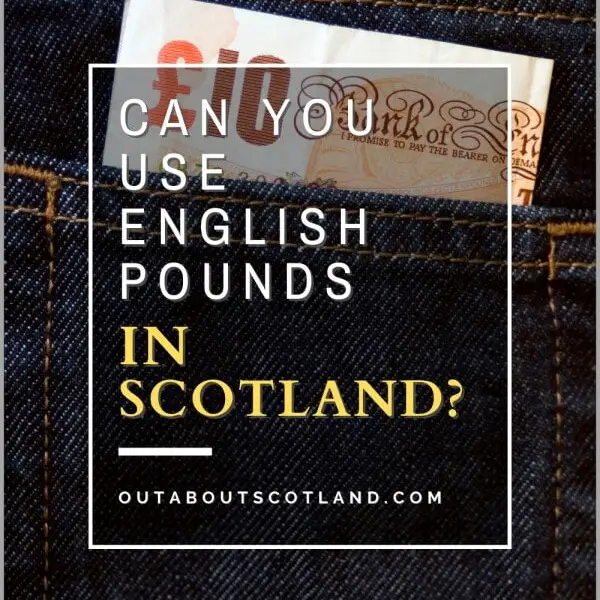Touring the United Kingdom for the first time can be a bewildering experience, as not only do visitors have four different countries to choose from, they also have to cope with differences in culture, differences in language, and differences in currency.
That last point isn’t strictly true as all countries in the UK accept the same currency – the Pound Sterling – but there are differences in the appearance of some of the banknotes. Even though English pound notes look different to Scottish notes they can still be used in Scotland and will be accepted in all Scottish stores and places of business, and vice versa for Scottish notes in England.
Notes and Coins in the United Kingdom

There are four countries in the United Kingdom: England, Wales, Scotland, and Northern Ireland, all of which use the British Pound as their currency. No matter where you are, the symbol £ or the abbreviation GBP always stand in for the pound.
Each pound is made up of 100 pence (usually identified with the letter ‘p’) and all coins are minted exclusively by the Royal Mint in denominations of 1p, 2p, 5p, 10p, 20p, 50p, £1 and £2. The Bank of Scotland, the Royal Bank of Scotland, and Clydesdale Bank print banknotes in Scotland, while the Royal Mint prints notes in England.
To help identify the value of each note they use a similar colour in each denomination, and there is a long-standing agreement between the three Scottish banks that they all produce notes with the same principal colours. The current main difference between English and Scottish banknotes are that the English £50 note is red while the Scottish £50 is green, and Scotland has £1 and £100 notes which England does not.
Banknotes can change design over the years, so check the Bank of England and Committee of Scottish Bankers websites for updates. Both the Royal Mint’s notes and those produced by the three Scottish banks are valid in Scotland. However, in practice, this isn’t always the case, and I’ll explain why in the next section.
Can I Use Scottish Money in England?

Scottish banknotes can be used in England, but they are technically not legal tender in any country – even Scotland – as they are classified as promissory notes, which is a legal document that states one party promises to pay another a certain amount of money.
Meanwhile, English banknotes are classified as legal tender, and this is where the confusion sets in. In practical terms, it is not a problem to use Scottish or English notes in Scotland because banks and shops will always accept them.
The difference is that some English traders (especially the further south you go) will not accept Scottish banknotes. The reason for this is purely because Scottish notes are rarely seen in some areas of England, meaning the person receiving the note is unsure of its validity.
While it’s understandable to get frustrated when this happens, it has to be remembered that shops outside of Scotland are not obligated to accept any specific type of payment and they could, in theory, ask for payment in shiny beads instead of banknotes (though they’d soon be out of business if they did).
One way to get around this confusion in England is to pop into a local bank and ask them to exchange your Scottish notes for English notes, which they will do at no cost. So, long story short, yes, you can spend Scottish banknotes in England, but you’ll have an easier life if you convert them to English notes before heading down south.
What Is Legal Tender?

‘Legal tender’ is one of those phrases that gets bandied about whenever there’s a dispute about Scottish and English banknotes, but the fact is it has no real meaning in everyday life. Scottish notes are not legal tender in England or Scotland, and English notes are not legal tender in Scotland (source: BOE website).
In England and Wales, Royal Mint coins and Bank of England notes are legal tender. In Scotland, Royal Mint coins and banknotes issued by the Bank of Scotland, the Royal Bank of Scotland, and Clydesdale Bank are legal tender.
Confusing, right? But what is legal tender?
In simplified terms, ‘legal tender’ means that if you offer to fully pay off a debt to someone in legal tender, they can’t sue you for failing to repay. So if you have a debt in England and offer to repay it with a Scottish note, because the note is not legal tender, the creditor can refuse it, even though it is a legitimate source of money. If you offer to repay the same debt with an English note, the creditor must acknowledge the debt is legally paid (source: Wikipedia).
Claiming a Scottish banknote is legal tender does not mean it has to be accepted in England. However, the majority of shops and supermarkets throughout the UK will accept both Scottish and English banknotes as they know they are official currency, regardless of the complexities of legal tender.
Can You Use Debit and Credit Cards in Scotland?

All the major card networks are accepted in Scotland, but not everywhere accepts all cards. From my own experience, while Visa and Mastercard are accepted in virtually all shops in Scotland (and the UK as a whole), American Express and Diners Club are refused in many stores.
When travelling in Scotland as an international visitor it’s therefore advisable to carry a card that is specifically designed for travel, such as Revolut which has low charges and good exchange rates. Revolut is easy to top up directly from your bank account via their app, and it’s accepted almost everywhere. Plus, it’s now possible to hold money in several currencies, which is ideal if you’re travelling around Europe.
Tip: If you get a travel card, you can save on foreign transaction fees by loading it with British pounds before you leave home.
Credit cards from Visa and Mastercard have several benefits, including travel insurance and rewards schemes, but their biggest benefit is that you can immediately block the card if it is lost or stolen.
The downside with these cards is they usually have high fees for cash withdrawals from ATMs, their exchange rates are often lousy, and they insist on transaction fees on every purchase – sometimes up to 3% which will soon mount up on an extended holiday.
Debit cards backed by Visa and Mastercard are usually cheaper for ATM withdrawals, but some have foreign transaction fees, no rewards, and limited customer service if the card is stolen.
It’s possible to get a hybrid credit card from many banks that combines the best features of a travel card with a credit card, i.e., no transaction fees, included travel insurance, and good exchange rates. The only downside is that you’ll have to pay for these benefits with a high APR.
A final option is traveller’s checks, but this once-popular form of money has been superseded by travel cards like Revolut. Traveller’s checks can be expensive when it comes to fees, and they’re a pain to exchange, but they’re still one of the most secure options for carrying money around.
Advice for Using Money in Scotland

1: If you arrive in England, Scotland or Wales as an international visitor you must declare if you’re carrying cash of £10,000 or more (not applicable to most of us, admittedly). This cash can take the form of notes and coins, bearer bonds, and traveller’s cheques, all of which must be declared as soon as you arrive. If this cash is not declared it can be seized and you can be issued a £5,000 fine.
2: All Scottish cities and towns, and most large villages, have ATMs where you can withdraw cash, but the majority will charge a transaction fee. One way to get around this is to use a card in a store that offers a cash back scheme where you pay for your goods plus an amount of cash via your card. The cashier then gives you the cash amount in notes (there’s usually a minimum in-store spend of £10 to be able to get cash back).
3: Another option of exchanging currencies is via Scottish banks and foreign exchange counters, though the latter option is discouraged as they have high commission rates, especially foreign exchange counters at airports.
To see the latest exchange rate for UK Sterling, head to the Bank of England website:
Scotland pound to Euro.
Scotland pound to USD.
4: Post-Covid, contactless payments via debit cards has risen from £30 to £100 in the UK. This is very convenient, but it also leaves shoppers open to cloning theft. This is where someone scans your card with a reader that clones its details onto another card that can subsequently be used to make contactless payments. You can combat this with an RFID-blocking wallet, such as this one from Amazon.
5: Many credit and debit cards come with additional costs to use them overseas, including international transaction fees, higher exchange rates, ATM fees, and cash advance fees. Recommended cards to use when travelling that have low fees are; ING Direct Orange, Citibank Saver Plus, Revolut, and Transferwise debit card.
6: As a handy tip, if you receive any of the UK’s new polymer banknotes make sure you push them into a closed wallet sleeve as they’re quite slippery and have a tendency to work their way out of pockets as you walk (I know this from personal experience). Polymer banknotes in Scotland are currently in denominations of £5, £10, £20 and £50.
Frequently Asked Questions
What Scottish notes are in circulation?
In most countries, only the government is allowed to print banknotes via their central banks. Scotland, however, is different as it allows three of its major banks to print their own notes – Bank of Scotland, Clydesdale Bank and The Royal Bank of Scotland.
Currently, Scottish banknotes in circulation are £1, £5, £10, £20, £50, and £100. Of these, the £5, £10, £20 and £50 notes are being re-circulated from paper to polymer.
What are the colours of Scottish banknotes?
The three Scottish banks that print their own banknotes – Bank of Scotland, Clydesdale Bank and The Royal Bank of Scotland – have agreed to use the same predominant colours in order to ease identification by the note holder.
The colours are; £5 – blue, £10 – brown, £20 – purple, £50 – green, £100 – red.
How can you tell if a Scottish note is real?
You can see if a Scottish banknote is real by holding it up to a light and looking for a watermark matching the portrait on the front of the note. There is also a thin metallic security thread that runs through the middle of each note.
New polymer notes have additional security features in the form of clear windows in certain areas of the note, holographic foil, microtext (only visible with a magnifying glass), and UV printing.
What do you do with fake banknotes?
If you are certain you have a fake banknote you must report it to your local police force (in the UK) as soon as possible. You can contact the police either at the police station or by phoning 101. Some police forces have online reporting systems.
If you are a shop owner that has received counterfeit notes, take a copy of the CCTV footage (if any) from the time the note was handed over and give it to the police.






